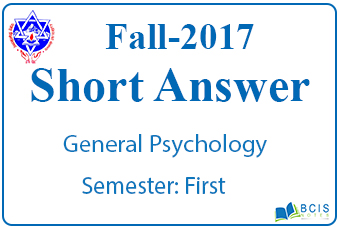
Very Short Questions Fall 2017
The answers to the Very Short Questions Fall 2017 are given below:
1. Illustrate the goals of scientific psychology.
ANS- The goals of psychology are:
- Describe
- Explain
- Predict
2. What are the structures of the brain that control emotion, learning, memory, and motivation?
ANS- The structures that control are:
- Emotion- limbic system
- Learning- cerebrum
- Memory- hippocampus
- Motivation- limbic system
3. Define a low ball technique?
ANS- The low-ball technique is a compliance strategy which is used to persuade a person to agree to a request. A person using the technique will present an attractive offer at first. The offer will be attractive enough for the other party to it. Then, before finalising the agreement, the person will then change the offer.
4. “Perception considered a top-down process”. Justify this statement.
ANS- In top-down processing, perceptions begin with the most general and move toward the more specific. These perceptions are heavily influenced by our expectations and prior knowledge. 1 Put simply, your brain applies what it knows to fill in the blanks and anticipate what’s next.
5. How does the sense of taste and smell work?
ANS- Smell and taste are the oldest of the senses. They are essential for survival, having evolved to play key roles in such basic processes as feeding, mating, and avoiding danger. As the two chemical senses, they work by allowing tiny bits—molecules—of the outside world into the body, and binding to them.
6. How do you differentiate punishment and negative reinforcement?
ANS- The difference between punishment and negative reinforcement is that in the first case, conduct is diminished, whereas, in the second, it is increased by stimuli. If you understand this particular difference, everything falls into place and the concept is no longer confused.
7. What does Schachter – the singer’s theory of the emotional state?
ANS- The Schachter-Singer theory of emotion, also known as the two-factor theory of emotion, states that emotions are a product of both physiological and cognitive processes.
8. What is I.Q? How can we calculate it?
ANS- An intelligence quotient (IQ) is a total score derived from a set of standardized tests or subtests designed to assess human intelligence. It is calculated by using the following formula:

9. What are the cognitive factors in stress?
ANS- Among the factors identified as particularly relevant to define the cognitive effects of stress are the intensity or magnitude of stress, its origin (i.e., whether triggered by the task or externally), and its duration (i.e., whether acute or chronically delivered).
10. Define an Id, Ego, and Superego.
ANS- The Id is the instinctual component of personality that is present at birth, and is the source of bodily needs and wants, emotional impulses and desires, especially aggression and the libido. The ego acts according to the reality principle; i.e., it seeks to please the id’s drive in realistic ways that, in the long term, bring benefit, rather than grief. The super-ego reflects the internalization of cultural rules, mainly taught by parents applying their guidance and influence.
You may also like Pokhara University || Fall,2017 || General Psychology

Leave a Reply